|
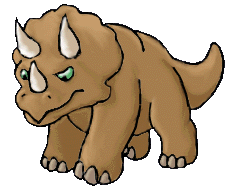  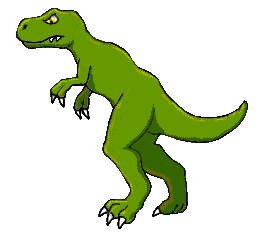
|
Literature
Patrick’s
Dinosaurs
by Carol Carrick
What Ever Happened
to Patrick’s Dinosaurs?
by Carol Carrick
What Ever Happened
to the Dinosaurs?
by Bernard Most
If the Dinosaurs
Came Back
by Bernard Most
Digging Up
Dinosaurs
by Aliki
My Visit to the
Dinosaurs
by Aliki
Danny and the
Dinosaur by
Syd Hoff
Bones, Bones,
Dinosaur Bones
by Byron Barton
Curious George and
the Dinosaur
by Margret and H.A.
Rey
Dinosaur Time
by Peggy Parish
A Dozen Dinosaurs
by Richard Armour
A First Look at
Dinosaurs
by Millicent Selsam and Joyce Hunt
Dinosaurs
by Gail Gibbons
The Dinosaur Who
Lived In My Backyard
by B. G. Hennessy
Can I Have a
Stegosaurus, Mom? Can I? Please!?
by Lois G.
Grambling
Dinosaurs,
Dinosaurs
by Byron Barton
Time Flies
by Eric Rothman
Dinosaur Roar!
by Paul and
Henrietta Stickland
Count-A-Saurus
by Nancy
Blumenthal
The Tyrannosaurus
Game by
Steven Kroll
Dinosaur Dream
by Dennis Nolan
Dazzle the
Dinosaur by
Marcus Pfister
Dinosaurumpus
by Tony Mitton |

|
Poems Songs
|
Tyrannosaurus
Rex, My Dear
(tune of John
Jacob Jingleheimer Schmidt)
(Repeat 3 times)
Tyrannosaurus rex,
my dear,
(Show claws, then fold hands
across chest.)
You cause such
fear!
(Frightened look on face.)
When your sharp
teeth you show,
(Point to bared teeth.)
I know it’s time to
go!
(Quickly flutter hands away
from body.)
Tyrannosaurus rex,
my dear,
(Show claws; then fold hands
across chest.)
Da-da-da-da-don’t
eat me
(Shake finger in front of body.)
(Last verse only) PLEASE!
(Fold hands together in front as
if to beg.)
 |
All
Around the Swamp
Tune: "Wheels on the Bus"
Pteranodon's
wings went flap, flap, flap;
Flap, flap,
flap; flap, flap, flap.
Pteranodon's
wings went flap, flap, flap,
All around the
swamp
Tyrannosaurus
Rex went grrr, grrr, grrr
Grrr, grrr,
grrr; grrr, grrr, grrr.
Tyrannosaurus
Rex went grrr, grrr, grrr ,
All around the
swamp.
Triceratops
horns went poke, poke, poke;
Poke, poke,
poke; poke, poke, poke.
Triceratops
horns went poke, poke, poke,
All around the
swamp.
Apatosaurus'
mouth went munch, munch, munch;
Munch, munch,
munch; munch, munch, munch.
Apatosaurus'
mouth went munch, munch, munch,
All around the
swamp.
Stegosaurus'
tail went spike, spike, spike;
Spike, spike,
spike; spike, spike, spike.
Stegosaurus'
tail went spike, spike, spike,
All around the
swamp. |
|
Dinosaur Ditty
(tune of Three
Blind Mice)
Di-no-saurs! Di-no-saurs!
Lived long ago, lived long ago.
Some were little as chickens, you see.
Some were so very much bigger than me!
Oh, wouldn't
you like to be able to see di-no-saurs?
More Dino Poems
Dinosaur Pie & Dinosaur Stomp from The K Crew |
Dinosaur Song
(tune of
Bringing home a baby bumblebee)
"I'm bringing
home a baby dinosaur
Won't my mommy
hide behind the door
I'm bringing
home a baby dinosaur."
Stomp, stomp,
stomp right through the door.
"I'm bringing
home a baby dinosaur
Won't my Daddy
fall down on the floor
I'm bringing
home a baby dinosaur."
Stomp, stomp,
stomp right through the door. |
|

|
Literacy
|
Student Book
“BIG!”
(borrowed
from Kim’s class books)
The students each get two simple dinosaur blacklines, possibly
“long neck” brachiosaurus. One blackline must be larger for
the “effect”. Students color both dinosaurs. The larger dino
will be cut up by the student in accordance with the text
written on each page. The appropriate body part will be glued
on the correct page.
The Pages:
-
Big feet. (student glues dino feet)
-
Big tail. (student glues tail)
-
Big neck. (student glues neck)
-
Big head. (student glues head)
-
Big body. (student glues body)
-
Big appetite. (child draws or glues a picture of a tree)
-
Little brain. (student glues a dried pea)
-
Big word! (student glues smaller dino picture and stamps
or cuts the letters out in square blocks to spell and glue
d-i-n-o-s-a-u-r)
The Cover:
The cover could be any color. Title: “Big Parts!”, “Big
Things”, or just plain “Big!”) The title could be run off in
sentence strips which the student could glue on. They could
decorate with dinosaur stamps or stickers or by making
dinosaur tracks. The “marker” is a popsicle stick with a
dinosaur sticker glued to one end.
(Kim’s books usually have a pocket glued to the back of the
cover to hold the “marker”, which the children use to point as
they reread the book.) |
Patterned Poem
If I Were a Dinosaur
(borrowed
from Mrs. Burns’ site)
Read A Dinosaur
Named After Me by Bernard Most. After reading the story,
look at pictures of different types of dinosaurs and compare
physical characteristics. (Some dinosaurs had two legs, some
had four. Some had long necks, some had spikes, etc.etc.)
Ask the children to create their own dinosaur using Crayola
Model Magic. When the molds dry allow them to paint their
dinosaurs using tempera paint. Ask the children to name their
dinosaurs after themselves, such as Maryosaurus Rex or
Edguanodon. You can even write poems for these dinosaurs,
using the pattern below:
If I were
a dinosaur,
A
__________________ I would be.
I would
eat __________________
And
__________________ I would see.
But since
I'm not a dinosaur,
I am
happy to be me!
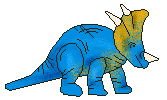 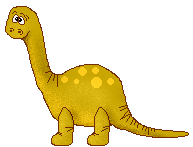 |
|
Other Student Book Ideas
If I Were A Dinosaur….
Each page can have a starter that students complete and illustrate.
My Dinosaurs Days Booklet
The Mailbox, Pre/K, Jan/Feb 1989
What Can Dinosaurs Do?
The Education Center (TEC251)
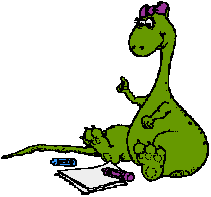 |
Bone Bank
Fold tagboard into a box shape. Two sides have a tropical
picture (palm trees, ferns). One side has a dinosaur. The
fourth side of the box is labeled, “__________’s Bone Bank”.
Write words, letters or numbers that need reinforcement on
small bone shapes. Students practice reading their bones and
putting them into the bone bank.
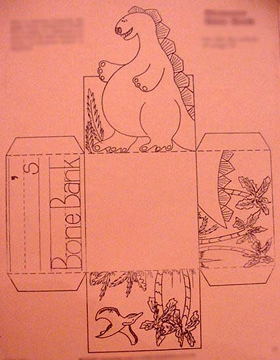
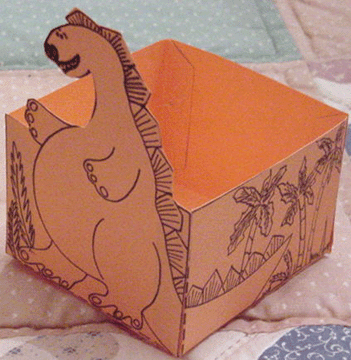 |
|
Journal Topic
Play Raffi’s song, “If I Had a Dinosaur”. Then have students
complete and illustrate this sentence starter: If I had a
dinosaur, I would _____________. |
Other Literacy Resources
Blacklines relating to comprehension of the book, “Patrick’s
Dinosaurs.” Worksheet Magazine, Kindergarten, April/May/June
1991 |
|

|
Math
|
One-to-one Correspondence/
Counting
Dino Hop Game
This activity is for two players. Make a line of 17 one inch
squares (it doesn’t really matter how many, but it must be an
odd number.) Place a toy dinosaur in the center square (square
nine if you made 17 squares in a line). The first player rolls
one die and hops the dinosaur toward his end of the line the
number on the die. The second player rolls the die and turns
the dinosaur in the other direction and hops that many spaces.
Play continues back and forth between the players until one
player finally reaches his end of the line of squares with the
dinosaur.

Digging for Dinos
Bury small dinosaurs in a tub of sand. Give each student a
container. They dig in the sand, find the dinosaurs and count
how many they found. |
Sorting/Graphing
Triceratops Tromp
(January, Kindergarten TEC)
Make a blackline of a triceratops in three sizes. Copy these
triceratops pictures on three different colors of paper. Cut
them out, punch a hole and make them into necklaces. Put three
hula hoops on the floor in the classroom. Give the necklaces
to nine students Explain that the students will perform a
dance called the Tricertops Tromp. Play some lively music and
call out either “Size” or “Color”. Students have to sort
themselves into the hula hoop rings on the floor. Let the
other students have a turn also.
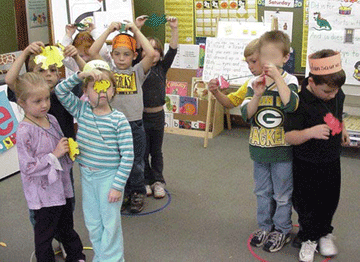
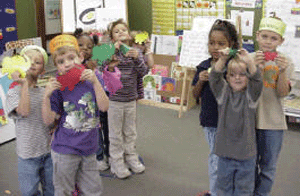
Sort
dinosaur manipulatives or cutouts by color or type of
dinosaur.
Graph the favorite dinosaur of the class.
Give students a handful of dinosaur manipulatives or cutouts.
Have them sort them and then graph them. |
|
Patterning
Use
dinosaur stamps, macaroni or manipulatives to make patterns.
|
Subtraction Readiness
Give a small group of students 10 small dinosaurs and have
them stand them in a straight line. Each student takes turns
rolling a die and removing that many dinosaurs from his line.
To win, the student must roll the exact number of dinosaurs he
has left. |
|
Measurement
Use an extended tape measure to demonstrate to students how
large dinosaurs were. Go to the playground and mark off these
lengths. Some examples are: Apatosaurus (70
feet),Tyrannosaurus Rex ( 50 feet), Stegosaurus (25 feet),
Ankylosaurus (15 feet) and Compsognathus (2 feet).
Choose one dinosaur and cut a length of yarn the same size as
the length of that dinosaur. Use the length of yarn to see how
many dinosaurs long various areas are—how many dinosaurs long
is the playground, the school, the hallway, the gym, etc.
 |
Division Readiness
This idea came from the book, Math Through the Alphabet, by
Sue Kerr. Get
12 small dinosaurs or pictures of dinosaurs. Put one dinosaur
in each section of an egg carton. Students must divide the
dinosaurs equally into groups. Tell students to imagine the
dinosaurs going out to explore each day. On the first day the
dinosaurs stayed together. On the second day, they split into
two groups. On one of the days there can’t be the same number
of dinosaurs in each group so they decided to stay home. They
can put an X on that day.
*The first worksheet has one large box on it and is labeled: 1
Group of ____ Dinosaurs.
*The second sheet has two large boxes on it and is labeled: 2
Groups of ____ Dinosaurs.
*The third sheet has three boxes and is labeled: 3 Groups of
____ Dinosaurs.
*The fourth sheet has four boxes and is labeled: 4 Groups of
____ Dinosaurs.
*The fifth sheet has five boxes and is labeled: 5 Groups of
____ Dinosaurs.
*The sixth sheet has six boxes and is labeled: 6 Groups of
____ Dinosaurs.
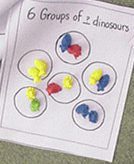 |
|

Science
|
Fossils
Make fossils by spreading clay (about a one inch thickness) in
a pie pan. Students then press small objects (small dinos,
buttons, keys, rocks, shells) into the clay to make
indentions. Pour about one inch of plaster of paris over this
clay and let it fill the indented spots and cover the rest of
the clay. When the plaster dries, remove it from the pie tin
and clay. Have students use the objects that formed the
fossils and try to fit them into the impressions.
More Fossils
(recipe for 6-8 fossils)
Mix together 2 cups of flour, 1 cup each of water and salt,
and 6 tablespoons of dry brown tempera paint to make mud.
Place the mud in a small pie tin and smooth out. Press a small
object in to the mud to create an impression. Set aside to dry
for several days. After they’re dry, put them and the objects
in a center and try to match the object to the fossil.
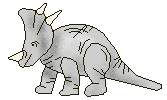
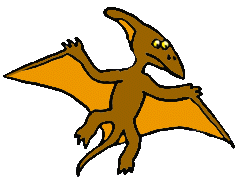 |
Dinosaur Dig Center
Materials:
Large tub filled with sand
Dried, clean chicken wing bones
Egg shells
Small rocks and seashells
Magnifying glasses
Tweezers
Small paint brushes
Pencils
Writing paper
Procedure:
Bury the items in the sand.
After reading books related to dinosaurs, explain to the class
that they will become paleontologists. Demonstrate how to
gently move the sand with the paint brushes to uncover their
archeological finds. The “finds” are then removed with the
tweezers and dusted. Next, the students examine their finds
with the magnifying glass.
The finds can be classified, sorted, measured, or graphed.
To extend the project to a writing center, make a blackline
that says, “I found….”. The students can write a list of what
they found, either using invented spelling or using picture
cards with the words provided by the teacher. Or the students
could draw a picture of what they found. This could be made
into a class book, “Our Fossil Finds.”
The students can rebury their finds for the next group of
students if you are rotating centers. |
|
Dinosaur Dig
Dinosaurs Unit by The K Crew:
Students explore tubs of sand to find “dinosaur bones". |
Dinosaur Characteristics
Make a chart of the differences between meat-eating
(carnivorous) dinosaurs and plant-eating (herbivorous)
dinosaurs. Include the number of feet they walk on, the shape
of the feet (claws), teeth, armor (bony plates, horns) or no
armor. Classify dinosaur models or pictures into these two
categories. |
|
Dinosaur Skeletons
It’s fairly easy to find dinosaur skeleton pictures or
blacklines. Copy these on transparencies. Then trace the
dinosaur outlines (without the bones) and cut them out.
Students put the transparency bones over the appropriate
dinosaur to show their skeletal system.
  |
Dinosaur “Trading Cards”
Copycat Magazine (Nov/Dec 93) had some cards that could be
folded for trading cards (the same size as baseball cards).
One side had a picture of a dinosaur and the back listed facts
about the dinosaur. There is a nifty carrying case with the
dinosaur mouth cut out to store the cards.
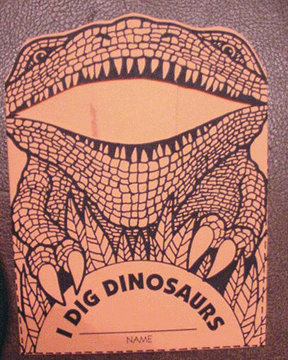
 |
|
Dinosaur Report
(from January
Monthly Reproducibles, Kindergarten)
Send home a page of information about a particular dinosaur
(could be copied from an encyclopedia) to enable parents to
help their child complete a "Dinosaur Report” about the
dinosaur. They should complete these sentences:
This dinosaur’s name is _____________.
It measured ________________.
It was a plant eater meat eater
(Circle one.)
It walked on 2 legs 4 legs
(Circle one.)
Its special features include
____________________________________.
Here is a picture of this dinosaur:
|
Another Dinosaur Dig
Mix vermiculite or
sand into plaster of paris and fill paper cups with a plastic
dinosaur hidden inside. Bury the 'rocks' in the sand table and
provide each child with a large nail and toothbrush to use for
excavating their find.
 |
|

|
Social Studies
|
Paleontologists
Fill
small eggs with dino treats such as stickers or dino gummies
(or you can purchase dinosaur eggs from Oriental Trading).
Bury these eggs in sand and have students find them.
|
Paleontologists
Dinosaurs Unit by The K Crew: Students use a toothpick to excavate chocolate chips from a
cookie. |
|

|
Art
|
Pasta Fossils
(from Crafts for Kids Who Are Wild About Dinosaurs by Kathy
Ross)
Materials:
Potting soil
White glue
Miscellaneous macaroni
Zip-lock bag
Paper or plastic plate
Foam brush
Instructions:
Put macaroni into a zip-lock bag and close. Break up macaroni
by stepping on the bag. With hands, mix several tablespoons of
glue int 1 ½ cups of potting soil. Continue adding glue until
dirt holds together. Mold into a bowl.
Press out soil ball on plate to 1/2 inch thick. Arrange
macaroni pieces on soil to look like a dinosaur skeleton.
Press pieces in. Brush a coat of white glue over entire
surface. Let dry overnight. Remove from plate. |
Dinosaur Eggs
Make paper mache
dinosaur eggs (put small plastic dinos in the eggs and let the
kids hatch them!)
Sculptured Dinosaurs
Make playdough or
Model Magic dinosaurs or fossil prints.
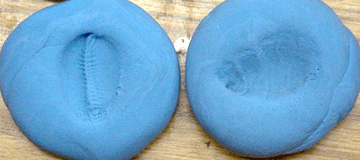
|
|
Museum Dinosaur
Use styrofoam packing
peanuts to make a dinosaur. Thread some thin wire (we have
used wire from a section of telephone cable and florist wire)
through the bottom of a paper plate so you have four strands
for legs, string packing pieces on the legs, twist the wires
together to make a body, tail and neck for stringing. This
takes a creative adult helper but the resulting product is a
pretty neat dinosaur that can be displayed in a showcase
'museum'. |
 |
|

|
Recipes
|
Dinosaur Dig
Have each student place a gummy dinosaur in the bottom of a
small cup. Fill the cup up with fruit loops cereal. Have
students dig and eat their way to the dinosaur at the bottom.
 |
Triceratops Treats
Make a triceratops bag topper labeled with “Triceratops Treats”
and put popcorn or dino treats into the bag.
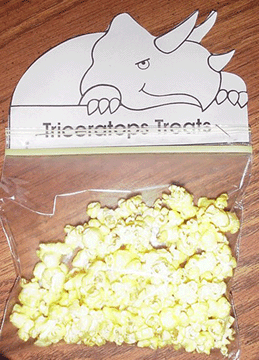 |
|
Dinosaur Food
Ingredients include dirt, swamp water, crushed bones, and more. Find all the details atDinosaurs Unit by The K Crew.
Dino Bones
1 cup peanut
butter
1 cup dry milk
2 tbsp. honey
graham
crackers, crushed
Combine peanut
butter and milk. Add honey. Mix well. Divide into equal portions
after shaping them into bones. Sprinkle with crackers.
|
Hatching Eggs
Put green jelly bean "dinosaur eggs" into cupcake papers that
serve as "nests". Top each bunch of eggs with a gummy dinosaur,
who is waiting for the eggs to hatch.

Dinosaur Dirt Digs
Mix instant chocolate pudding with white chocolate chips and
place in a clear plastic cup. Top off with crushed cookie
crumbs. Have the children pretend they are going on a dinosaur
dirt dig and finding dinosaur bones (white chocolate chips).
Their spoons are their shovels.
|
|

|
Fun Activities
|
Dinosaur Day
Have centers set up for the students to rotate among to
complete various activities:
Bone Bank (see literacy above)
Dino Bingo Game-bingo game card with a dinosaur in the free
space
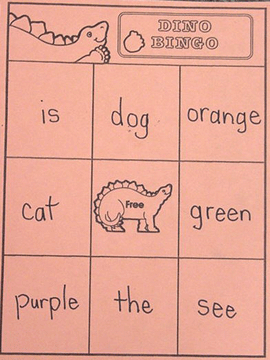
Dinosaur Trading Cards (see science above)
Dino Hop game (see math above)
Triceratops Treats (see recipes) |
Dino Pokey
You put your
claws in/claws out/scratch 'em all about.
You put your
feet in/feet out/stomp them all about.
You put your
teeth in/teeth out/chomp them all about.
You put your tail in/tail out/wag it all about.
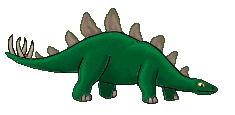
 |
|
Dino Treasure Hunt
Make dinosaur
footprints and place them around the room to follow the trail
to a treasure. |
Be
a Stegosaurus
Use paper grocery
bags and make one child the head, one the tail and the rest
the stegosaurus spines. |
|
Pin
the Horn on the Dinosaur
Enlarge a Triceratops
pattern to make a Pin the Horn on the Dinosaur game.
 |
Dinosaur Names
Make
headbands by writing "dino names" and stamping with dino stamps.
 |
|

|

.gif)